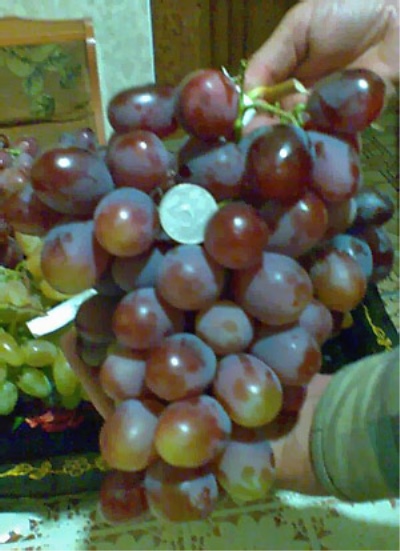
- Authors: Kapelyushny Vasily Ulyanovich
- Appointment: dining room
- Berry color: bordeaux at full maturity
- Taste: harmonious
- Ripening period: early middle
- Ripening period, days: 125-135
- Frost resistance, ° C: -24
- Bunch weight, g: 800-1200
- Flower type: bisexual
- Peeling: No
The Count of Monte Cristo grape is a popular aromatic variety that is highly resistant to frost and pests. It is worth taking a closer look at the features of grapes and making out the planting rules.
Breeding history
The variety was bred by the domestic breeder Kapelyushny. To get the grapes Count of Monte Cristo, a gardener from the Rostov region crossed two other varieties, thus creating a unique bush.
Description
The variety is distinguished by large clusters, easy care. Suitable for making delicious juices, wines. Characteristic features of the variety:
large bush size;
flexible vine;
thick and large leaves.
The advantages of the culture include fast ripening and excellent taste of berries. The grapes are suitable for storage, are resistant to pests.
Ripening period
The first berries appear closer to the beginning of August. However, in colder regions, grape ripening begins in early September.
Bunches
The bunches of the variety are large, conical in shape. The weight of one bunch reaches 800 grams, and in the best cases - 1.2 kg.
Berries
The Count of Monte Cristo grapes have large oval berries, the color of which varies from deep red to dark pink. On ripe berries, you can also notice a matte bloom. Inside, the berry has a fleshy pulp with a high glucose content.
Taste
The grapes have a harmonious, slightly sour taste.
Yield
The variety gives a high yield with proper care. The grapes stop yielding only 7-8 years after planting.


Growing features
Cultivation of grapes Count of Monte Cristo requires compliance with a number of agrotechnical requirements. For example, it is recommended to regularly fertilize and water the soil in a timely manner to provide the plant with the necessary amount of nutrients and achieve high yields.
Landing
Small bushes of grapes are advised to be planted in early spring before sap flow. You can also plant seedlings in mid-September, when the plants begin to go into hibernation and do not require careful maintenance. When choosing grapes for planting, you should pay attention to the following features:
the planting material must have 4 or more buds;
the roots of the seedling should have a light shade.
Additionally, it is recommended to check the roots for rot and damage. Otherwise, the seedling will not take root.
It is better to choose light, spacious areas with a neutral groundwater level and no winds as a landing site. It is important that the soil in which you plan to grow grapes has a lot of nitrogen.
Before planting a crop, it is necessary to clear the ground of stones and weeds that can interfere with the growth of the bush. Additionally, you will need to dig a landing hole with a depth of 60 cm. Fertile soil, humus and sand should be poured into the bottom of the hole in a ratio of 1: 1: 0.5.
Landing Algorithm:
first, drainage is laid in the pit;
then the roots of the seedling are cut to ensure the flow of oxygen, the bush is set in the hole, where the soil mixture is poured;
the third stage involves backfilling the hole and tamping.
At the end, it remains to water the seedlings with warm water. In this case, a small amount of mineral fertilizers can be dissolved in water.

Pollination
Pollination of grapes is carried out by insects when it comes to growing crops in the garden. In the case of planting seedlings in a greenhouse, it is worth taking care of artificial pollination of the buds.
Pruning
Old branches should be removed in the spring before the start of sap flow. Lateral shoots are mainly cut off. And it is also necessary to remove stepchildren, the appearance of which can negatively affect the yield.

Watering
It is recommended to water the grapes once every 3 days. One bush requires up to 1 bucket of warm water.


Top dressing
Regular fertilization of the soil in which the grapes grow will help to obtain high yields. Gardeners are advised to make top dressing in spring, summer and autumn. At the first stage, a large amount of nitrogen fertilizers will be required, at the second, it is better to use complex mineral fertilizers. In the autumn period, humus must be introduced into the soil, capable of giving the roots of grapes the necessary nutrients.
Frost resistance and the need for shelter
The variety tolerates frost well, therefore it is able to survive in winter regions. In the first years after planting grapes, it is worth covering the bushes so that frosty winds do not harm the trunk and roots. And also gardeners recommend before frosts:
pour humus and a layer of sawdust;
use burlap for young vines;
insulate the root part.
The listed recommendations will help create the necessary conditions for the preservation of the plant.

Diseases and pests
The Count of Monte Cristo is a pest and disease resistant variety. The culture is rarely attacked by rot and aphids, so the bush is popular with gardeners.

If a grape is exposed to any disease or insect, this always affects its appearance.
Storage
The bunches collected after ripening are put in a box.It is recommended to store grapes in dry rooms.











































































